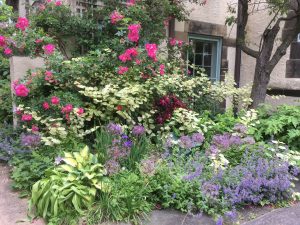
Rosa ‘John Cabot’, Fallopia, Allium christophii, Nepeta ‘Dropmore Hybrid’, Iris siberica ‘Welcome Returns’, Allium christophii, Hosta ‘Red October’
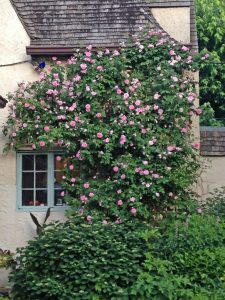
Unknown rose (label lot many years ago) on kitchen wall
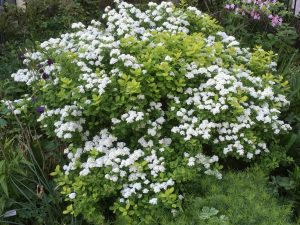
Spiraea ‘Glow Girl’ – not enough nurseries are growing this cultivar
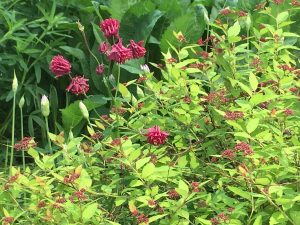
Spiraea ‘Magic Carpet’ with Aquilegia ‘Ruby Port’
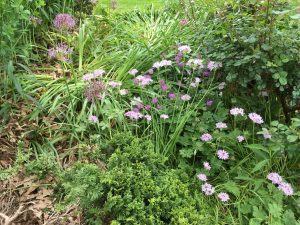
Allium roseum, christophii

Iris spuria ‘Spring Plum’. Allium nigrum, Rosa Oso Easy ‘Petite Pink’, Weigela ‘Wine and Roses’, Buddleia foliage, Iris ensata ‘Oriental Eyes’
Those of us who garden are blessed. There is something new to see almost every day. June weather, although a seesaw of temperatures and moisture, has given us glorious blooms. The roses are prolific, the iris have been lovely, the color of spirea foliage has been bright, the peonies were entrancing until heavy rains knocked off all the petals, and all of the alliums, in their various guises, have brought us joy.
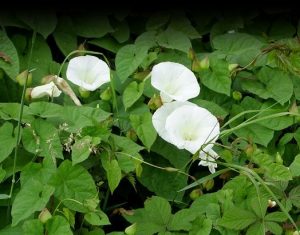
Bindweed (henrystreetgardencentre) may have lovely flowers but is incredibly destructive.
The only downside is that the weeds have also been prolific. I’m trying to do daily bindweed search and destroy missions because it tends to overtake weakly stemmed perennials like Thalictrum. Mine, although six feet tall, had been pulled over to a height of three to four feet.
I’m sure that many of you plant spring flowering bulbs in the fall and enjoy their bloom in the spring but do you deadhead them to prevent the bulb from spending its energy on making seed instead of using that energy to ensure bloom next year?
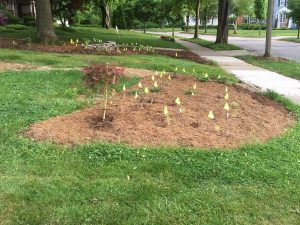
Bed too small for future growth of Japanese maple
As I drive around and meet with clients, I see some common mistakes that can be avoided. All too often, trees and shrubs are planted too close to the house or the driveway because the installer forgets to allow space for mature growth. Another is that new beds are often too small to allow for future growth. Therefore, in a few years, the tree or shrub will need to be transplanted or the bed will have to be enlarged.

Root flare is pale but you can see it.
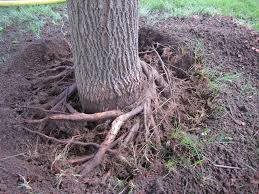
Girdling roots-flickr
The other disastrous mistake is one of ignorance that even supposed professionals make – that is, not finding the tree’s root or trunk flare. The flare is where the trunk expands at the base of the tree and it should be partially visible after the tree has been planted. Quite often, you must remove soil from the top of the root ball prior to planting. If the tree is planted too deeply, it often leads to girdling roots that end up killing the tree. What happens at many nurseries is that mechanical weeding often throws soil over the ground where the young trees are, thus burying the root flare. In addition, a covered root flare leaves the trunk wet (as does too much mulch) and, therefore, vulnerable to infections and disease.
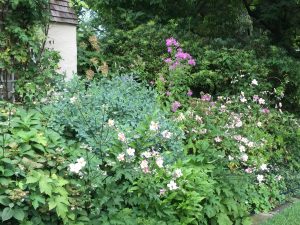
Anemone, japonica, Phlox paniculata ‘Shortwood’ in August

October garden – Hydrangea macrophylla Let’s Dance® Rhapsody Blue, Rosa ‘Natascha’, zinnias, Clematis viticella ‘Walenburg’
It’s always tempting to buy whatever is in bloom at a garden center but try to think about the rest of the summer and the fall. What will be in bloom then? When it gets really hot out there, are you still gardening and shopping for plants? Constantly assess empty spaces ( heaven for weeds). What would enhance your landscape in those spots? Plants will give more joy than mulch.


0 Comments